AGRICULTURAL SCIENCES GRADE 12 QUESTIONS - 2018 JUNE EXAM PAST PAPERS AND MEMOS
Share via Whatsapp Join our WhatsApp Group Join our Telegram GroupAGRICULTURAL SCIENCES
GRADE 12
NATIONAL SENIOR CERTIFICATE
JUNE 2018
INSTRUCTIONS AND INFORMATION
- This question paper consists of TWO sections, namely SECTION A and SECTION B.
- Answer ALL the questions.
- Write ALL the answers in your ANSWER BOOK.
- Start the answers to EACH question at the top of a NEW page.
- Number the answers correctly according to the numbering system used in this question paper.
- Non-programmable calculators may be used.
- Show ALL your calculations, including units and formulae, where applicable.
- Write neatly and legibly.
SECTION A
QUESTION 1
1.1 Various options are provided as possible answers to the following questions.
Choose the answer and write only the letter (A–D) next to the question number (1.1.1–1.1.10) in the ANSWER BOOK, for example 1.1.11 D.
1.1.1 The succus entericus which is a clear, slightly alkaline slimy liquid, is secreted by the glands of …
- Moolman.
- Langerhans.
- Lieberkühn.
- the thyroid.
1.1.2 In young ruminant animals, the … transports milk that is taken directly to the abomasum.
- blind gut
- pyloric valve
- caecum
- oesophageal groove
1.1.3 The part of the alimentary canal, from the diagram below that is known as the soft glandular stomach and secretes digestive juices.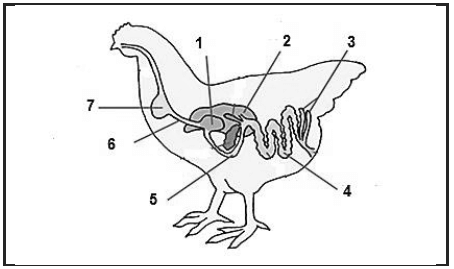
- 6
- 7
- 1
- 2
1.1.4 The following is TRUE about microbial fermentation:
- Large quantities of carbon dioxide, methane and oxygen gases are produced
- Poor quality feed increases the amount of methane gas produced
- Energy is generated through this process and used by ruminants and microbes
- It takes place under anaerobic conditions
Choose the correct combination below:
- (i), (ii) and (iv)
- (ii), (iii) and (iv)
- (i), (ii) and (iii)
- None of the above.
1.1.5 The statements below are correct with regard to the life cycle of a onehost tick:
- The eggs hatch into larvae
- The larvae develop into nymphs
- The nymphs live all of their lives on an intermediate host
- The nymphs develop into adults which transmit diseases
Choose the CORRECT combination:
- (i), (ii) and (iv)
- (i), (ii) and (iii)
- (i), (iii) and (iv)
- (ii), (iii) and (iv)
1.1.6 The statements below apply to a feedlot production system:
- Zero grazing is practiced
- Labour and capital intensive production system
- Animals are kept at very low density on large areas of land
- Shade and shelter are provided for animals
Choose the correct combination:
- (i), (ii) and (iii)
- (ii), (iii) and (iv)
- (i), (iii) and (iv)
- (i), (ii) and (iv)
1.1.7 Zoonotic diseases are diseases that …
- if they occur, it is required by law to notify the government authorities.
- can be transmitted from animals to humans and from humans to animals.
- are non-infectious.
- are caused by nutritional deficiencies.
1.1.8 The picture below shows pre-mating behaviour where the bull extends its neck, curls its upper lip prior to mating, and it is known as …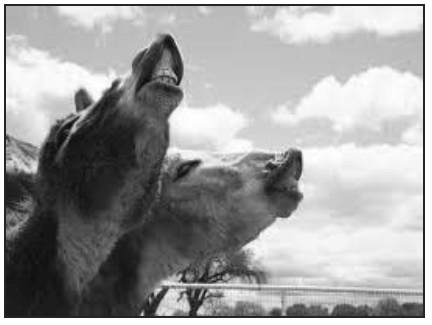
- flehmen response.
- copulation phase.
- ejaculation stage.
- erection.
1.1.9 The membrane that attaches the foetus to the uterus is the …
- placenta.
- chorion.
- allantois.
- amnion.
1.1.10 Interstitial cells called … are found in the parenchyma of the testes between the seminiferous tubules.
- myoepithelial cells
- egg cells
- leydig cells
- rete cells (10 x 2) (20)
1.2 Indicate whether each of the following statements in COLUMN B applies to A ONLY, B ONLY, BOTH A AND B or NONE of the items in COLUMN A.
Write A only, B only, both A and B or None next to the question number
(1.2.1–1.2.5) in the ANSWER BOOK, for example 1.2.6 B only.
Example:
| COLUMN A | COLUMN B | |
| A: | Roughage | A feed with a high percentage of TDN |
| B: | Concentrate | |
| COLUMN A | COLUMN B | ||
| 1.2.1 | A | Narrow | nutritive ratio (NR) of 1 : 3 |
| B | For growth and reproduction | ||
| 1.2.2 | A | Maintenance ration | The feed given to an animal to do work and synthesise output |
| B | Production ration | ||
| 1.2.3 | A | Fungal disease | An example is anaplasmosis |
| B | Bacterial disease | ||
| 1.2.4 | A | Blind spot | The area out of the animal’s front line of vision |
| B | Flight zone | ||
| 1.2.5 | A | A Cryptorchidism | The condition where the testes in the scrotum are underdeveloped |
| B | Hypoplasia | ||
(5 x 2) (10)
1.3 Give ONE term/phrase for each of the following descriptions. Write only the term/phrase next to the question number (1.3.1–1.3.5) in the ANSWER BOOK.
1.3.1 The measure of the digestibility of a feed expressed as a percentage of dry matter
1.3.2 An external parasite which is a three-host tick responsible for transmitting heart water in sheep
1.3.3 A powerful contraction of the urethra responsible for the ejection of semen into the vagina during mating
1.3.4 An abnormal condition that hinders the parturition process in which cerebrospinal fluid accumulates in the ventricles of the brain and causes an enlarged skull
1.3.5 The period, in producing dairy cows, which starts after parturition and normally continues for an average of 305 days (5 x 2) (10)
1.4 Change the UNDERLINED WORD in each of the following statements to make them TRUE. Write only the appropriate word next to the question number (1.4.1–1.4.5) in the ANSWER BOOK.
1.4.1 The population of bacteria in the rumen that is responsible for digesting starch is proteolytic organisms.
1.4.2 Flight zone is the crossing point at the shoulder at 90° on an imaginary line that follows the animal’s spine.
1.4.3 The acrosome releases an enzyme called cellulase that facilitates sperm penetration of the ovarian wall.
1.4.4 Gestation is the period where the offspring are taken away from their mothers and selected for inclusion into the herd.
1.4.5 Semen is a yellowish, salty creamy liquid secreted from the mammary glands at parturition and provides antibodies. (5 x 1) (5)
TOTAL SECTION A: 45
SECTION B
QUESTION 2: ANIMAL NUTRITION
Start this question on a NEW page.
2.1 The diagrams below represent the alimentary canals of different farm animals.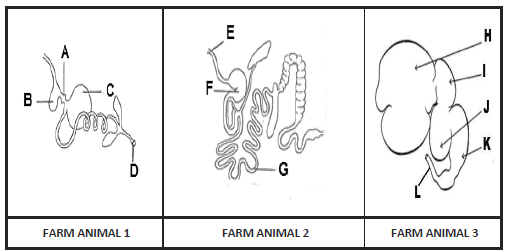
2.1.1 Identify parts D and J. (2)
2.1.2 Indicate the letter of the part where the following processes occur:
- Fermentation through the combined action of bacteria, protozoa and fungi in FARM ANIMAL 3 (1)
- Secretion of digestive juices in FARM ANIMAL 1 (1)
- Food is pushed downwards by the involuntary contraction and relaxation into the stomach in FARM ANIMAL 2 (1)
2.1.3 Explain how the first part of the small intestine labelled L is protected against stomach acids. (2)
2.1.4 The small intestines are adapted for the absorption of soluble digested food molecules. Support this statement. (2)
2.1.5 FARM ANIMAL 2 has three pairs of salivary glands. Give the name of the one found below or behind the ear. (1)
2.2 Suggest the name of the diseases caused by deficiency of the following vitamin/mineral:
2.2.1 Pyridoxine (1)
2.2.2 Zinc (1)
2.3 Read the following scenario and then answer the questions that follow.
| In a feed trial, a cow ingested 15 kg of lucerne hay and egested 4 kg of manure. The feed intake is expressed as dry matter and 40% of the excretor is moisture. |
2.3.1 Calculate the digestibility coefficient of lucerne hay. Show ALL your calculations. (4)
2.3.2 Based on the results in QUESTION 2.3.1, suggest ONE factor that might have influenced the digestibility of hay. (1)
2.3.3 Suggest how a farmer can improve the digestibility of grain feeds. (1)
2.4 The diagram below is a schematic representation of the energy flow of feeds: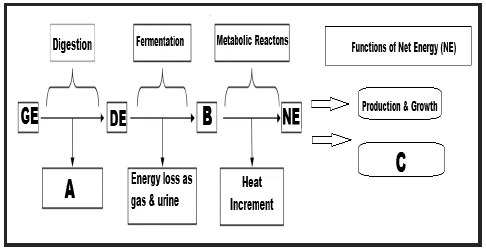
2.4.1 Complete the energy flow diagram by identifying A, B and C as presented above. (3)
2.5 The graph below shows the feed components required by animals at different stages of development: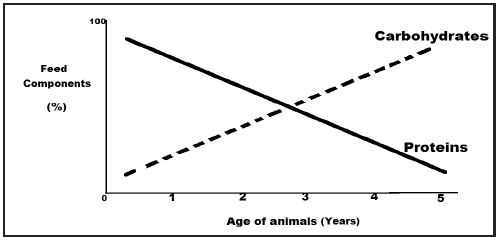
2.5.1 Deduce from the graph the age of the animal that is mostly fed a maintenance ration. (1)
2.5.2 Give a reason for the answer in QUESTION 2.5.1 based on the graph above. (1)
2.5.3 According to the graph protein requirements of the animal at one year is very high. Give a reason. (1)
2.6 The results shown below were obtained in trying to balance Feed A and Feed B for the herd of dairy cows.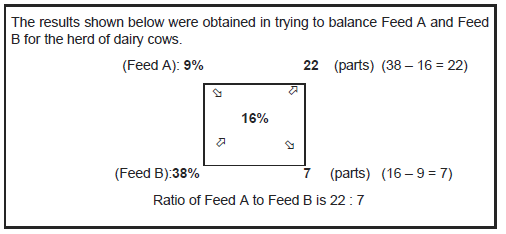
2.6.1 Indicate the part in the ratio that represents a protein-rich concentrate from the Pearson square above. (1)
2.6.2 Give a reason for the answer in QUESTION 2.6.1. (1)
2.6.3 Calculate the percentage of Feed A required in the mixture. (2)
2.6.4 Determine the amount in tons of Feed B needed to prepare 850 kg of the mixture. (3)
2.7 The graph below illustrates a fodder-flow programme. Answer the questions that follow.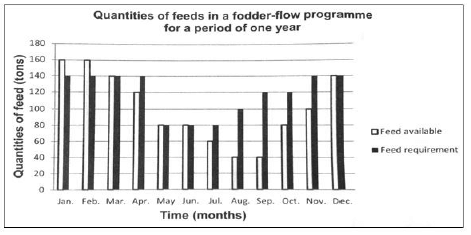
2.7.1 Indicate the month during which the available feed will be most insufficient for the animals. (1)
2.7.2 Calculate the surplus amount of feed during the month of February in kilograms (kg). (3)
[35]
QUESTION 3: ANIMAL PRODUCTION, PROTECTION AND CONTROL
Start this question on a NEW page.
3.1 Read the following scenario, and then answer the questions that follow.
| With climate changes, managing temperatures in cattle is becoming increasingly more important. The normal average daily feed consumption and water requirements for the non-lactating beef animal with a body weight of 450kg is 15 kg and 20 litres of water.  |
3.1.1 Deduce the environmental condition the animal in the picture above is subjected to. (1)
3.1.2 Provide TWO reasons based on the picture for the answer in QUESTION 3.1.1. (2)
3.1.3 Recommend TWO measures a farmer can take to address the challenge in QUESTION 3.1.1. (2)
3.1.4 Define homoeothermic. (1)
3.2 Read and analyse the following information.
A trial was done on 20 dairy cows and the results showed that on average each animal consumed 4,6 kg of feed and the body mass gained was 1,3 kg.
3.2.1 Calculate the Feed Conversion Ratio of the feed indicated above. (2)
3.3 The pictures below represent two animal production systems.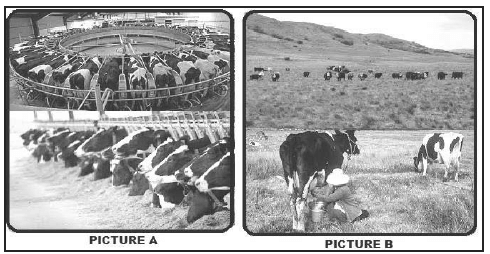
3.3.1 Identify the animal production systems represented by PICTURE A and PICTURE B in the illustrations above. (2)
3.3.2 Justify the answer to QUESTION 3.3.1 based on the pictures. (2)
3.3.3 Relate subsistence and commercial farming systems to the production systems mentioned in QUESTION 3.3.1. (2)
3.4 Analyse the following picture and then answer the questions that follow.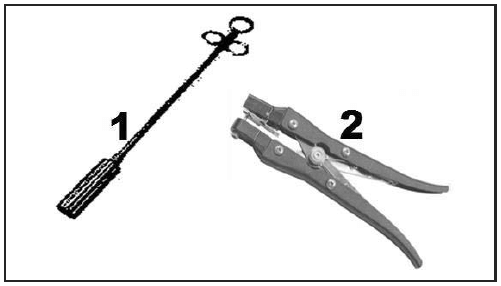
3.4.1 Identify the devices marked 1 and 2 shown in the picture above. (2)
3.4.2 Suggest the use of each device mentioned in QUESTION 3.4.1. (2)
3.5 Read the following case study and then answer the questions that follow.
| Control of animal health as well as eradication of diseases in animals, especially foot and mouth disease (FMD), are critical for national and international trade. Animal diseases caused by micro-organisms, such as bacteria and viruses, may lead to serious infectious animal diseases. |
3.5.1 Suggest the pathogen that causes FMD. (1)
3.5.2 Indicate the impact of an FMD outbreak on the South African economy. (1)
3.5.3 FMD is a notifiable disease. Explain this statement. (2)
3.5.4 Indicate the name of the disease applicable to each of the following statements below:
- A viral disease in poultry causing respiratory distress, nasal discharge and paralysis of wings and legs (1)
- A protozoal disease that affects intestinal tract resulting in convulsions and muscle tremors (1)
3.5.5 Suggest a way in which the farmer can prevent the infection of the disease in QUESTION 3.5.4 (a). (1)
3.6 The seriousness of a disease depends on how long a disease lasts and how quickly it develops. The following graph represents three levels of seriousness of the disease.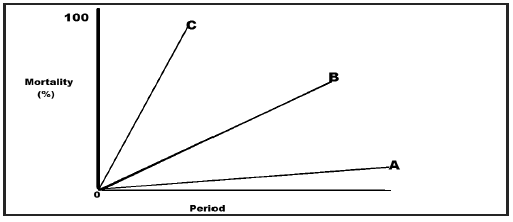
3.6.1 Identify the levels of seriousness of a disease as represented by A, B and C in the graph. (3)
3.7 The illustration below represents the life cycle of a parasite.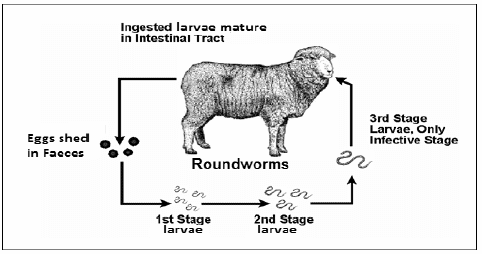
3.7.1 Classify the parasite in the illustration above. (1)
3.7.2 There are three main types of parasites in the class mentioned in
QUESTION 3.7.1. Name the other TWO not indicated in the diagram above. (2)
3.7.3 Give the name of the disease which causes a serious loss of blood due to parasite infestation shown in QUESTION 3.7. (1)
3.8 Study the following picture, and then answer the questions.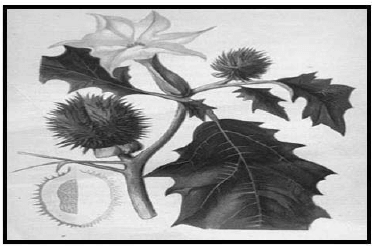
3.8.1 Identify the plant shown in the picture above that may be poisonous to animals. (1)
3.8.2 Name TWO measures to prevent poisoning of animals by the plant in the picture above. (2)
[35]
QUESTION 4: ANIMAL REPRODUCTION
Start this question on a NEW page.
4.1 The diagram below illustrates the sperm cell and reproductive system of a bull.
4.1.1 Identify the parts labelled 2 and 4 in DIAGRAM B above. (2)
4.1.2 Supply THREE functions of the part labelled 5. (3)
4.1.3 Mention the name of the hormone secreted by the part labelled 1. (1)
4.1.4 Name the biological process that occurs in the part labelled 1, by which diploid germ cells undergo cell division and differentiation to form mature haploid male gametes. (1)
4.1.5 Identify parts A and C from DIAGRAM A above. (2)
4.1.6 Give ONE function for each of the parts identified in QUESTION 4.1.5. (2)
4.2 The diagram below shows the reproductive process of farm animals.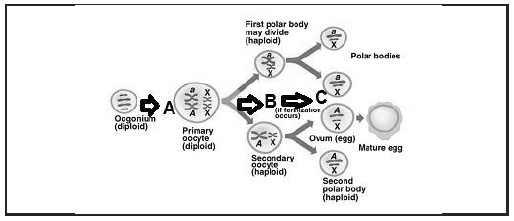
4.2.1 Name the reproductive process illustrated above. (1)
4.2.2 Identify the types of cell division that occur at points A and B. (2)
4.2.3 Suggest where the process, mentioned in QUESTION 4.3.1, takes place. (1)
4.3 The illustration below shows a reproductive process of male and female animals in its chronological order.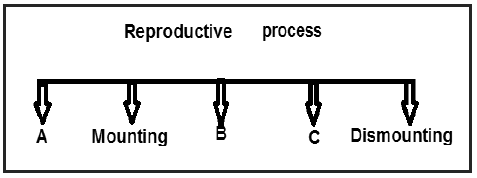
4.3.1 Identify the reproductive process illustrated in the schematic representation above. (1)
4.3.2 Supply the names given to stages A, B and C in the correct order. (3)
4.4 The table below shows the percentage of cows showing signs of oestrus at different times of the day.
| Times of the day | Percentage of cows showing signs of oestrus | Number of animals involved in the experiment |
| 06H00–12H00 | 25% | 32 |
| 12H00–18H00 | 10% | 28 |
| 18H00–00H00 | 36% | 44 |
| 00H00–06H00 | 45% | 40 |
4.4 4.4.1 Use the information provided in the table above to draw a bar graph representing the percentage of cows showing signs of oestrus at various times of the day. (5)
4.4.2 Identify the time of the day during which the least number of cows show signs of oestrus. (1)
4.5 The following picture shows equipment used in the animal reproduction industry to perform various management operations on the farm.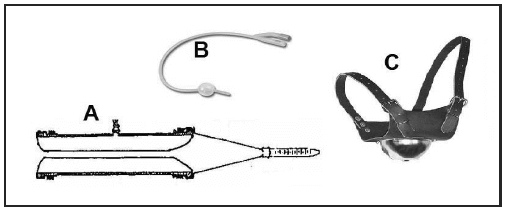
4.5.1 Identify the letter of the equipment that can be used for each of the functions below:
- Assists the farmer in identifying a cow on heat (1)
- To recover the embryo from the uterus of the donor (1)
- To collect semen from the bull (1)
4.5.2 Name TWO basic requirements for semen collection. (2)
4.6 Analyse the following illustrations and pictures and answer the questions that follow.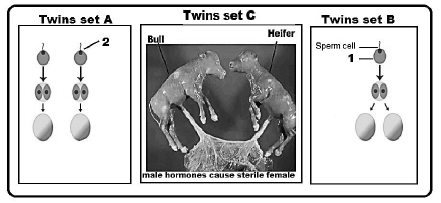
4.6.1 Name the types of multiple births (A, B and C) illustrated in the pictures above. (3)
4.6.2 Identify the part labelled 1 on the twin set B above. (1)
4.6.3 Suggest the name of the process indicated in 2 on twin set A above. (1)
[35]
TOTAL SECTION B: 105
GRAND TOTAL: 150